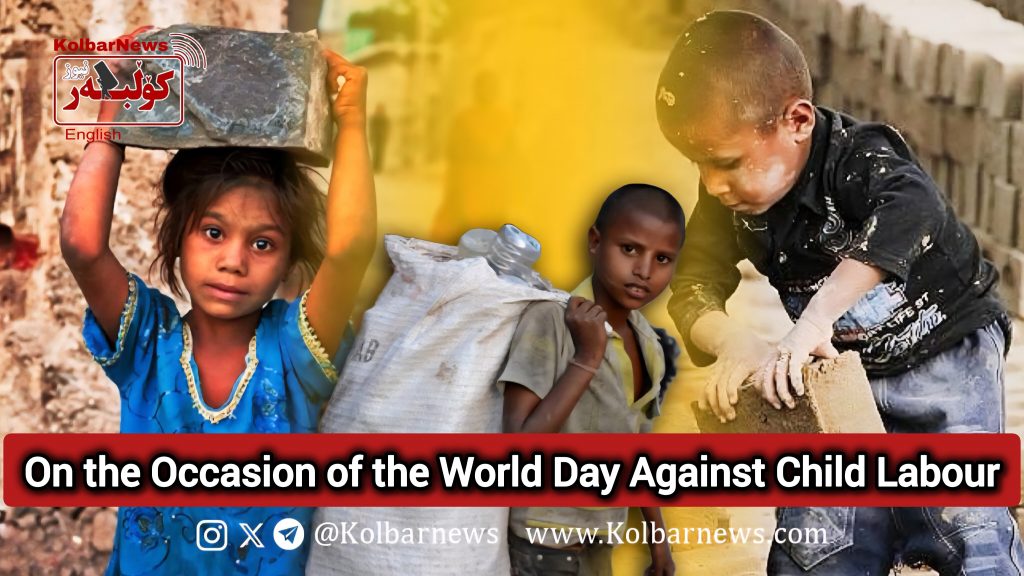
Thursday, June 12, marks the World Day Against Child Labour. This day was established by the International Labour Organization (ILO) in 2002. There has never been a precise global statistic on the number of child laborers, largely because most governments, especially in underdeveloped capitalist countries, are unwilling to provide accurate data. According to UNICEF, the United Nations Children’s Fund, around 215 million children aged 5 to 17 were engaged in professional labor in 2012, working over 40 hours per week, either for pay or unpaid.
In Iran, official statistics speak of approximately 3 million child laborers. However, unofficial estimates place the number as high as 7 million. While no figure can truly capture the full scope of this human tragedy, even the lowest estimates represent a deep disgrace for the capitalist system and a painful wound on the conscience of humanity.
All forms of professional work are harmful to children, but some are outright dangerous. Of the estimated 215 million child laborers reported by UNICEF, 115 million are engaged in hazardous work. The scope of child labor spans all sectors: domestic work, agriculture, industry, trade, mining, and services. In all of these areas, children are exploited like slaves.
The most dangerous instances of child labor involve military use, criminal networks, and sexual tourism. More recently, exploitative practices have emerged in digital industries, including video games, pornography, and entertainment content. Capitalists of all scales from small shopkeepers to multinational corporations exploit the cheap and obedient labor of boys and girls. According to ILO statistics, 22,000 children die annually while working under exploitative conditions.
Child labor is more prevalent in underdeveloped capitalist countries than in industrialized ones, where progressive workers and citizens have forced capitalists and their governments to adhere to a minimal level of humanity. One of the regions where children have faced the worst exploitation and humiliation is occupied Palestine. Today, especially in Gaza, these children are facing death from bombings, shellings, disease, and severe starvation.
In developed countries like the United States, child laborers are often the children of immigrants and workers who lack official residency or work permits. Displacement caused by natural disasters and wars, coupled with rising poverty and unemployment, has also greatly contributed to the increase in child labor.
Iran is one of the countries where child laborers face slave-like conditions. Under the rule of the Islamic Republic, the plight of child laborers has become a full-blown catastrophe. Most of these children, between the ages of five and fifteen, are the children of working-class and impoverished families. Due to their parents’ poverty and unemployment, they are forced to forgo education and personal development, the natural rights of every child and instead endure hard, exhausting labor. Their youth withers under the burden of work. They are compelled to work day and night in carpet workshops, small factories, on city streets carrying heavy loads, washing car windows, selling cigarettes, tissues, gum, and more all to scrape together enough money to feed themselves, often scavenging for food in garbage dumps.
These child laborers include Afghan refugee children as well. Many are employed in extremely dangerous work like waste scavenging, controlled by trash mafias in major cities.
Addicted children, child marriage, child abuse, mandatory hijab for young girls, the imprisonment or execution of parents leaving young children orphaned, corporal punishment in schools, the forced participation of children in religious ceremonies, “Basij child soldiers” the list of horrors goes on endlessly.
Child labor is not a conscious choice made by children. These children are deprived of education and play due to poverty and are pushed into the brutal labor market. Because of capitalism’s insatiable need for cheap labor, they face unbearably bleak futures. In many countries, capitalists and their political representatives have reduced public support systems for children to force them into silent, brutal exploitation for subsistence wages.
The Islamic Republic of Iran has nominally accepted international conventions banning child labor. But in practice, this regime treats those laws as mere formalities. It ignores both the content of the conventions and the criticisms raised by international organizations.
Therefore, in order to secure the rights of child laborers the silent victims of capitalism, a different path must be taken. That path is none other than uniting and collectively struggling against the regime and the exploitative and oppressive system that so ruthlessly robs the most defenseless members of society of their basic human rights.

